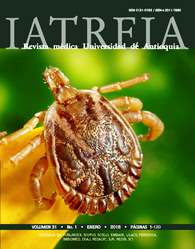Pharyngeal injury during a difficult orotracheal intubation in a new born infant. Report of the case
DOI:
https://doi.org/10.17533/udea.iatreia.v31n1a09Keywords:
children, difficult airway, intubation, oropharynx, traumaAbstract
Infants with complications during labor, prematurity, or birth defects may be at risk when they require orotracheal intubation. We report the case of a full-term female infant with a dysmorphic syndrome, seen at a second level hospital in Bogotá, who required orotracheal intubation due to episodes of apnea and cyanosis 5 hours after birth, while she was in bed with her mother. After multiple attempts at orotracheal intubation, there was bleeding from a difficult-to-identify source. Finally, the anesthesiologist secured the airway with a laryngeal mask. She was referred to our institution where a panendoscopy revealed a penetrating lesion, three centimeters in depth, at the right vallecular. We present the assessment, the treatment, its alternatives and the evolution of the patient.
Downloads
References
(1.) American Society of Anesthesiologists Task Force on Management of the Difficult Airway. Practice guidelines for management of the difficult airway: an updated report by the American Society of Anesthesiologists Task Force on Management of the Difficult Airway. Anesthesiology. 2003 May;98(5):1269-77. Erratum in: Anesthesiology. 2004 Aug;101(2):565.
(2.) O’Dell K. Predictors of difficult intubation and the otolaryngology perioperative consult. Anesthesiol Clin. 2015 Jun;33(2):279-90. DOI 10.1016/j.anclin.2015.02.002.
(3.) Navaratnarajah J, Black AE. Assessment and management of the predicted difficult airway in babies and children. Anaesth Intensive Care. 2012 May;13(5):226-33. DOI 10.1016/j.mpaic.2012.02.002.
(4.) Xue FS, Zhang GH, Li P, Sun HT, Li CW, Liu KP, et al. The clinical observation of difficult laryngoscopy and difficult intubation in infants with cleft lip and palate. Paediatr Anaesth. 2006 Mar;16(3):283-9.
(5.) Akpek EA, Mutlu H, Kayhan Z. Difficult intubation in pediatric cardiac anesthesia. J Cardiothorac Vasc Anesth. 2004 Oct;18(5):610-2.
(6.) Scheller B, Schalk R, Byhahn C, Peter N, L’Allemand N, Kessler P, et al. Laryngeal tube suction II for difficult airway management in neonates and small infants. Resuscitation. 2009 Jul;80(7):805-10. DOI 10.1016/j.resuscitation.2009.03.029.
(7.) Vijayasekaran S, Lioy J, Maschhoff K. Airway disorders of the fetus and neonate: An overview. Semin Fetal Neonatal Med. 2016 Aug;21(4):220-9. DOI 10.1016/j.siny.2016.03.004.
(8.) Divatia JV, Bhowmick K. Complications of endotracheal intubation and other airway management procedures. Indian J Anaesth.2005;49(4):308-18.
(9.) Quintero Buitrago C. Lesiones orales en el manejo de la vía aérea. Rev Col Anest. 2008;36:121-32.
(10.) Domino KB, Posner KL, Caplan RA, Cheney FW. Airway injury during anesthesia: a closed claims analysis. Anesthesiology. 1999 Dec;91(6):1703-11.
(11.) Sejwal S, Tandon M, Ganjoo P, Sharma A. Pneumomediastinum due to hypopharyngeal injury during orotracheal intubation. Can J Anaesth. 2007 Sep;54(9):767.
(12.) Wastler KE. Difficult intubation resulting in surgical repair of esophageal and hypopharyngeal perforation. AANA J. 2015 Feb;83(1):21-7.
(13.) Tartell PB, Hoover LA, Friduss ME, Zuckerbraun L. Pharyngoesophageal intubation injuries: three case reports. Am J Otolaryngol. 1990 Jul-Aug;11(4):256-60.
Published
How to Cite
Issue
Section
License
Copyright (c) 2018 Universidad de Antioquia

This work is licensed under a Creative Commons Attribution-NonCommercial-ShareAlike 4.0 International License.
Papers published in the journal are available for use under the Creative Commons license, specifically Attribution-NonCommercial-ShareAlike 4.0 International.
The papers must be unpublished and sent exclusively to the Journal Iatreia; the author uploading the contribution is required to submit two fully completed formats: article submission and authorship responsibility.















